Everything you need to know about mini air conditioners

The main problem in the warm season is constant heat and stuffiness, which only high-quality ventilation and cooling systems can cope with. Today, mini-models of air conditioners are rapidly gaining popularity: they are compact, inexpensive and can be used on travel. In this article, you will learn everything you need to know about mini-air conditioners: about their popular varieties, how they work and how to use them.

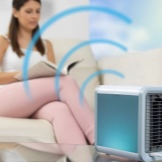
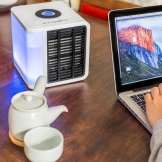
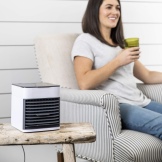
Device and characteristics
Each model of the air conditioner has an original device and is adapted for use in certain conditions. A classic inexpensive mini air conditioner can be arranged as follows:
- a body or block in which all the components are placed;
- fan for efficient outlet of cooled air;
- control panel with a basic set of commands;
- water tank or closed system for circulating refrigerant;
- cartridges or porous filters for filtration and evaporation of warm air;
- air duct (in mobile, but volumetric models), through which heated air is conducted to the street;
- cable for connecting to an outlet, cigarette lighter or USB port.
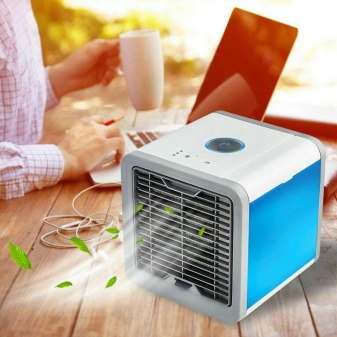
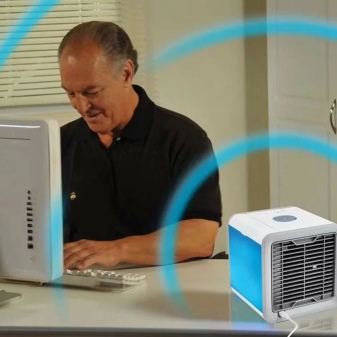
In addition to the main components, modern small air conditioners have a number of functions and characteristics, able to make the process of using the air conditioner even more enjoyable:
- the presence of an ionizing filter;
- several speeds of cooled air supply;
- additional filters and cartridges to retain dust and harmful substances, as well as eliminate unpleasant odors;
- on and off timers, auto shutdown in case of breakdown;
- dehumidification and humidification of the air;
- the possibility of heating and cooling;
- adjustment of the direction of air flows.
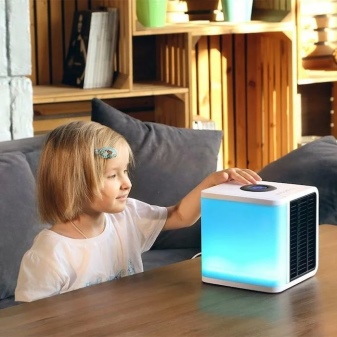
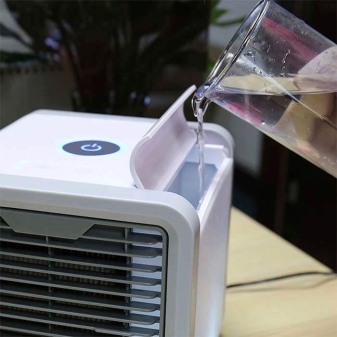
As you can see, modern mini-air conditioners are equipped with about the same set of useful functions and characteristics as full-fledged split systems.
Principle of operation
It will be easiest to get acquainted with the principle of operation of a mini-air conditioner using the example of more voluminous mobile models. In air conditioners of a mobile type, as in most models of refrigerators, freon is used to cool the air, which constantly circulates inside the closed system of the device. Compressed freon in a liquid state enters the evaporator and cools it. The refrigerant then passes through the compressor, is compressed again into a liquid state and enters the condenser, which heats up.
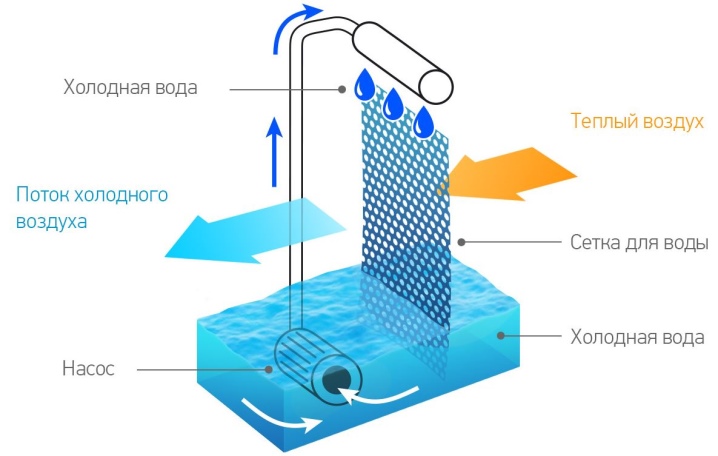
The air itself, which enters the air conditioner through the heat exchanger in the evaporator, is cooled and is supplied to the outside through the fan. Already another stream of air that enters the condenser cools it, and excess heat is removed outside (or outside) using an air duct. It is believed that quality it is the models of air conditioners with an air duct that are capable of cooling the air in a room, however, in mini-air conditioners it is usually absent, since they do not have freon as a refrigerant, but ordinary water... This usually does not provide an optimal level of cooling, but it raises the humidity in the room significantly.

Advantages and disadvantages
Today, mini-air conditioners continue to rapidly gain popularity against the background of already traditional split systems or bulky air conditioners. This demand can be explained by the many advantages of mini-models of air conditioners.
- Saving space. Small air conditioners can be used even in the smallest spaces with limited space. They do not take up as much space as traditional split systems. These models can be easily installed on a shelf, table or nightstand, or in a convenient corner on the floor.
- Low energy consumption. Modern mini-air conditioners are in no way inferior in capacity to overall split systems, while usually consuming much less electricity.
- Autonomy and mobility. While standard air conditioners usually operate from the mains, then small and mobile models are equipped with special replaceable batteries, on which the device can operate continuously for up to several weeks. This allows you to transport air conditioners by car, use them in tents, in the country or on a bus.
- Price. If the price for ordinary air conditioners and split systems can reach several hundred dollars, then 15-20 dollars may be enough for you to buy a mini-air conditioner of average quality.
- Possibility of self-creation. The most primitive models of mini air conditioners can be created by you even at home. To do this, you will need no more than 2 free hours, as well as several types of materials that can be found in almost every apartment. This is also the practicality of small models - it is much easier for them to find a suitable part or replace it yourself.
- Simple installation. After purchase, all classic models of air conditioners and split-systems require professional installation in compliance with all standards for exhausting air to the street. Here you need to be confident in the quality of the mounting fasteners and monitor their integrity. As for mini-air conditioners, then some kind of installation is superfluous. You just buy a model, fill it with water (if necessary) and enjoy its work (with mobile options, the operating principle is slightly different). In addition, you can change the location of your device at any time, which in the case of traditional models can be difficult.
- Security. If under the flow of air from the air conditioner you can really get sick, then in mini-models it is not so powerful as to cause such inconvenience. In addition, these devices are usually made of environmentally friendly materials and operate on the basis of health-friendly refrigerants. This is especially true for large families with small children.
- Excellent performance. As already mentioned, mini air conditioners have almost the same functions as conventional ventilation systems.
- Wide choose. Today the ventilation systems market is represented by a huge selection of mini-air conditioners made in a wide variety of designs and dimensions.
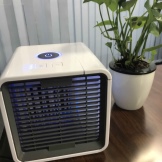


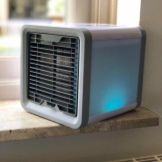
Small air conditioners have their drawbacks, however, they usually appear only in certain low-quality models.
- High noise levels are the main scourge of most cheap air conditioners. It can be distracting, interfering with sleep for you and your children.
- A standard set of a mobile air conditioner usually includes a corrugation that is too short or an air duct that is not long enough for many rooms.
- A common problem in cheap models is the insufficient quality and long cord for connecting to the network.
- Floor-standing models most often lack convenient wheels that could facilitate the operation of the device.
- Despite everything described, the most common problem when choosing a mini-air conditioner is the lack of its power. As a result, the device cannot cope with the given area, but only raises the humidity in the room and contributes to the appearance of condensation on the walls.
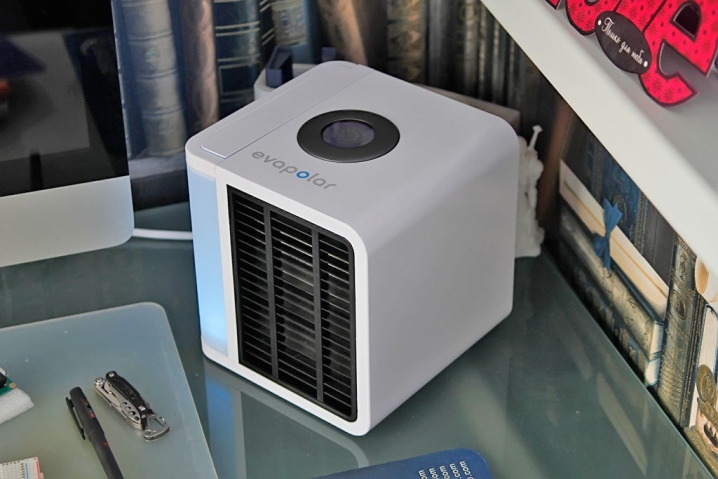
Views
Depending on the type of device and the principle of its operation, all mini air conditioners can be divided into two varieties:
- monoblock versions of air conditioners, which, in turn, are divided into window, mobile and portable;
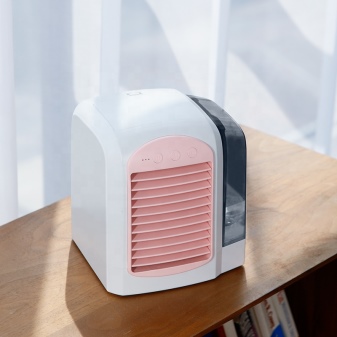
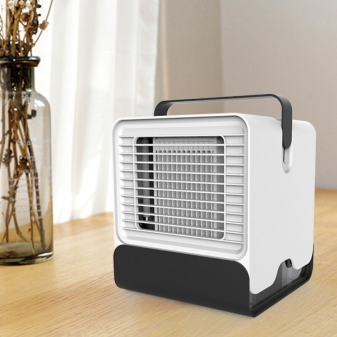
- compact wall-mounted split systems - more expensive air conditioners with the need for installation and lack of mobility.

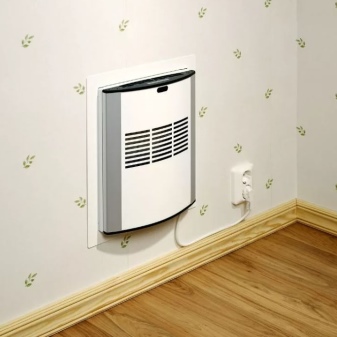
The choice between these varieties should be made based on the future conditions of their use. For example, if you are buying a mini one-piece air conditioner, be prepared for constant noise in the room. After all, the compressor for monoblock models will in any case be located inside the room. This can be a problem when placing the model in a room with pets or children. With split systems in this regard, it is usually easier, even if these are mini-models.
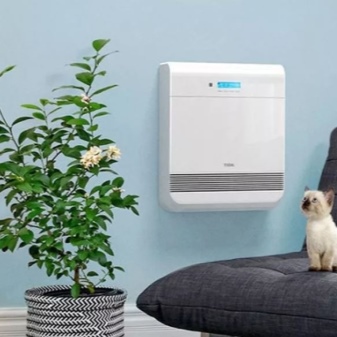
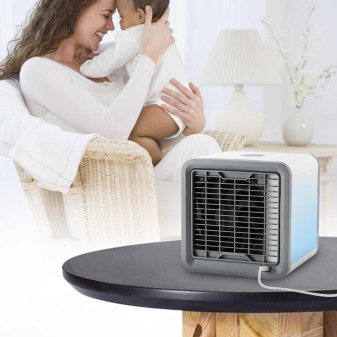
It is worthwhile to familiarize yourself in more detail with the varieties of monoblock mini-air conditioners, as well as with the pros, cons and features of using certain types.
Window
These models of air conditioners are placed in a window or fixed in a window. They are very compact in size - usually no more than 40 * 40 * 30 cm. The power of such devices is usually enough for cooling or heating small rooms from 6 to 12 square meters. meters. Today, such world-renowned brands as Haier, Toshiba and Midea are engaged in the manufacture of these ventilation systems. These devices have their pros and cons.
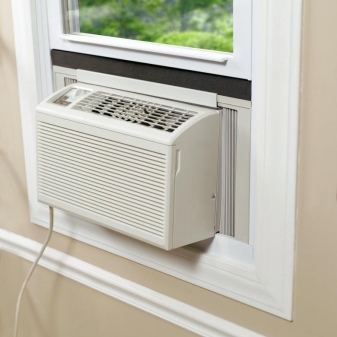
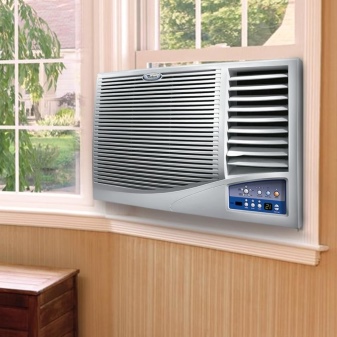
Pros:
- easy self-assembly and cheap installation with the help of a wizard;
- compact and closed system with a minimum number of components that can break;
- use little electricity even at maximum capacities;
- able to serve up to several years.
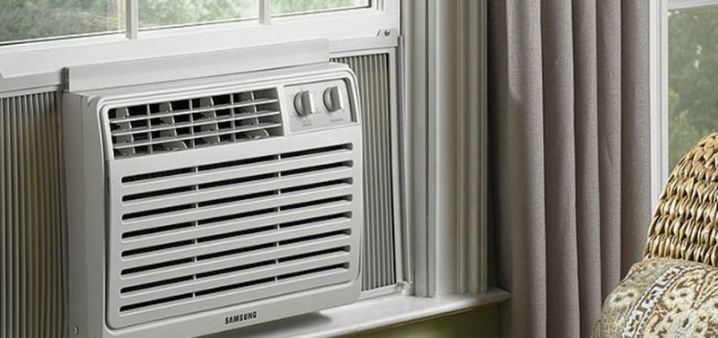
There is only one disadvantage of such models, but it is significant - a high cost, comparable even to the price of standard air conditioners.
Mobile
These are larger and more powerful options for air conditioners. Usually they are equipped with a special corrugation or air duct, designed to release air to the street and cool the condenser. The dimensions here are no longer so pleasant, usually 60 * 40 * 30 cm. Among the most popular brands that are engaged in the production of similar equipment, Electrolux can be distinguished. Pros of mobile models.
- There is no need for installation, it is possible to install it almost anywhere. Can be freely used outside the apartment if a power supply or battery is present.
- Low power of the fans, due to which it is impossible to catch a cold near such a device.
- There are no bulky outdoor units. This does not force the owner to spoil the facade of the building.
- With a competent and timely planning of the room, taking into account this device, it is possible to install a mobile mini-air conditioner without prejudice to the interior of the room.
- The devices can be made in a variety of designs. Often they become a full-fledged part of the interior of a room and can even complement a certain style.
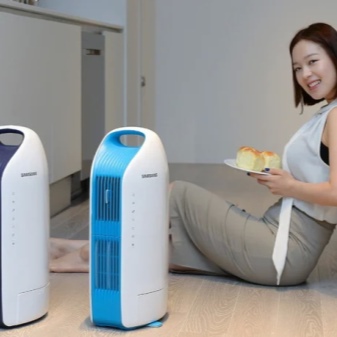

Minuses:
- increased temperature near the duct;
- high probability of condensation accumulation inside the device;
- low efficiency when processing several rooms due to the influence of third-party warm flows;
- short length of the duct;
- rather high cost of quality models.

Portable
These air conditioner options are considered the smallest among the rest. Due to their small size, they can sometimes be confused with a humidifier, coffee maker, or even the original alarm clock. Chilled water, which is placed directly into the device body, acts as a cooling agent. Such models can operate both from batteries and from the mains or USB. Obvious pluses.
- They can be used in absolutely any conditions and premises. Freely transported from place to place both indoors and outdoors.
- The complete absence of any installation. All that is required from the owner is to turn on the device and adjust its power.
- One additional feature is a significant reduction in the level of humidity in a small room.
- The original appearance, the ability to observe the water level.
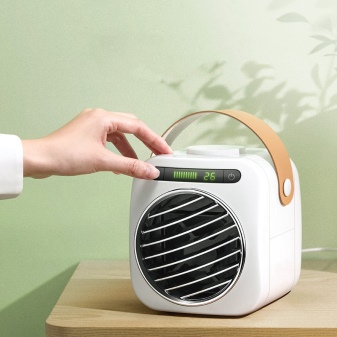
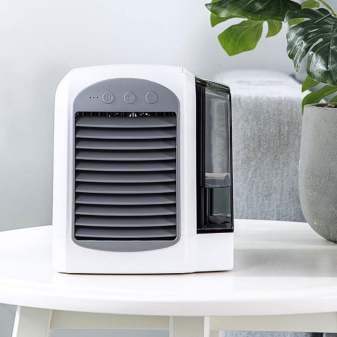
Minuses:
- the most important is low power, which allows the device to work effectively only in the smallest rooms;
- as a rule, such models have low build quality and quickly break down.
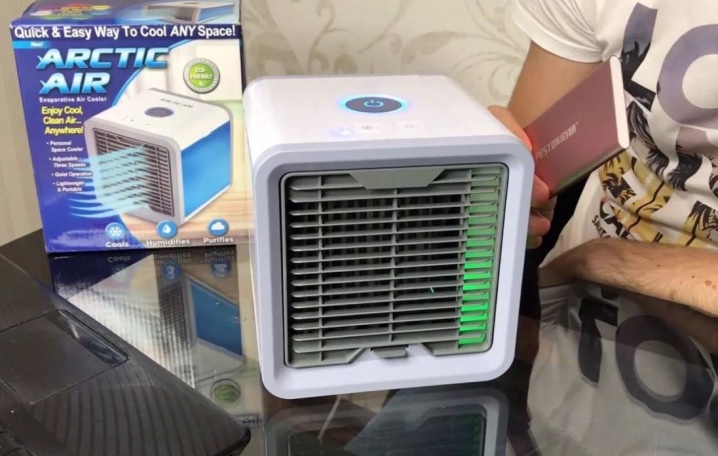
Compact split systems are a separate type among other air conditioners. This is a great option for consumers who prefer quality ventilation with minimal noise and space saving. Small split systems are usually much smaller than the same mobile air conditioners, however, they are equipped with a large outdoor unit that needs to be installed outdoors.
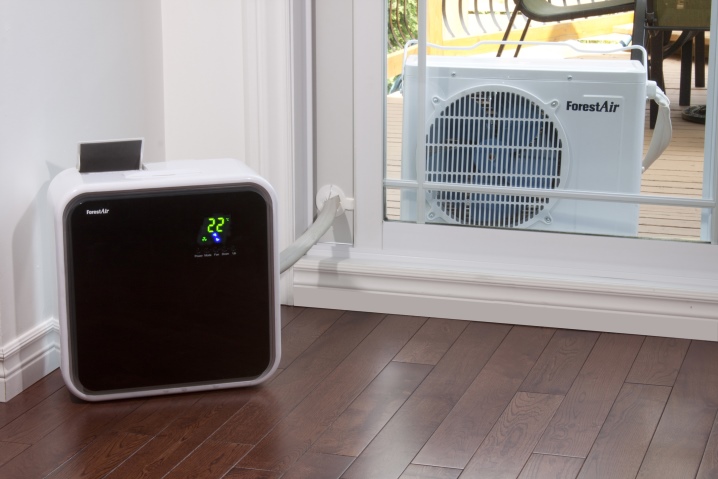
Today, American and Japanese brands occupy a leading position in the production of high-quality miniature split systems.
The advantages of split systems.
- Increased power and efficiency due to the presence of an air duct and a large selection of speeds.
- The internal unit of the device is located at the ceiling of the room, thus does not interfere with moving around the apartment and does not interfere with the installation of other furniture. What's more, by wall-mounting the unit to a ceiling, there is less risk of damage from pets or children.
- Split systems can have an original design and fit perfectly into a certain style solution.
- Low noise due to insulated outdoor unit and duct.

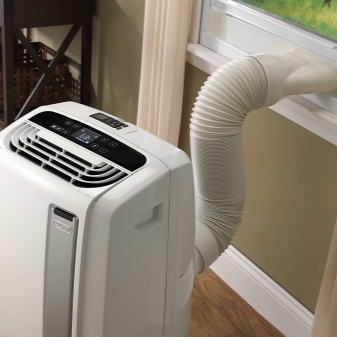
Minuses.
- Increased cost of quality models.
- The need for regular and constant maintenance of equipment.
- High-quality and expensive installation of both external and internal units is required. For installation, you will need to drill holes in the walls and facade of the building for fastenings.
- In the event of a breakdown, repairs will require the purchase of expensive components and spare parts.
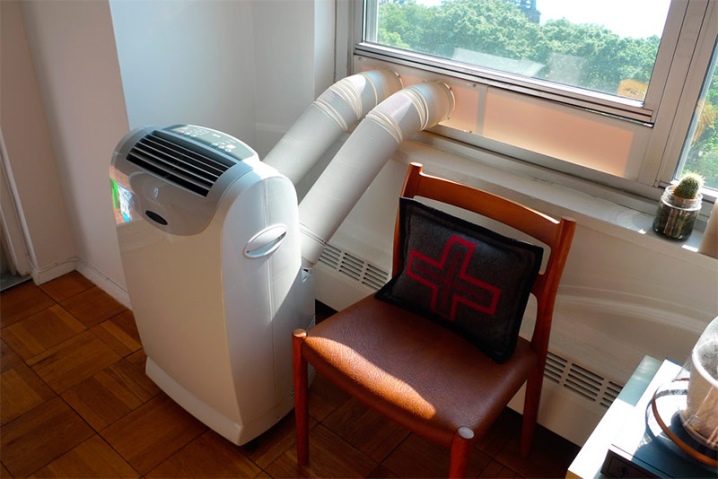
Model overview
The most popular and the best should be considered, according to Internet users, models of mini-air conditioners in the current season.
- Rovus "Arctic" 4 in 1. Portable version of a compact air conditioner for travel, hiking and trips to the country. The device operates on ordinary water and is capable of qualitatively refreshing any small room in a matter of minutes. An additional plus can be considered as many as 3 air flow rates. The only drawback is the need to constantly purchase new cleaning filters.

- Fast Cooler Pro. The main advantage of this miniature model is its surprisingly quiet operation, which makes it ideal for purchase in children's and bedrooms. It is one of the best models for cooling small spaces. Also, the model can be called mobile, since it is capable of operating both from the mains and from batteries (up to 2 hours). Regarding the principle of operation, this model is very simple - ordinary water is placed in a container, where it is evaporated, cooled and purified using special filters.
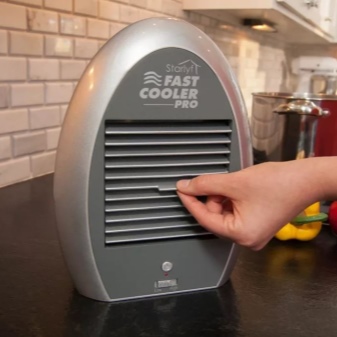
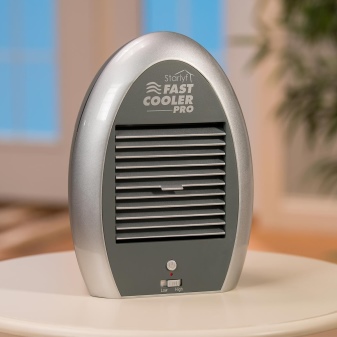
- Evapolar. An excellent model for consumers who see in any device not just a technique, but also an addition to the interior. This is a very pleasant and beautiful model of an air conditioner, capable of increasing the humidity level in a room and lowering the temperature in it by 10-12 degrees in a short time. This model is considered one of the safest - its cartridges are made of biologically pure and degradable material, and it runs on ordinary water and does not dry the air at all. An additional plus for gadget lovers - it can work via USB.

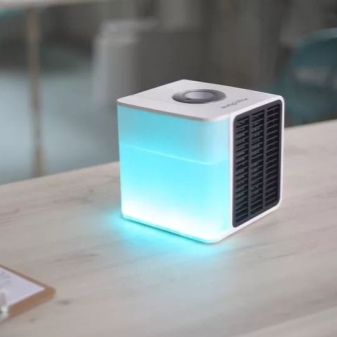
- OneConcept. A quality model of a German-made mobile air conditioner. It is considered one of the best for office and large premises. It has an increased size, but it includes 4 main functions at once: cleaning, humidifying, cooling and washing the air. The device operates through a high-quality air filter humidified with ordinary water from a built-in tank. An excellent addition to the main functions will be functional and convenient wheels, as well as a rather long cable.This model is extremely powerful compared to other models and can handle up to 400 cubic meters of air per hour.
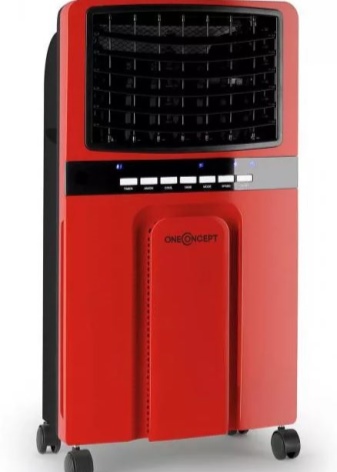

- Minifan. Considered the best handheld model for long journeys. In addition to a small but pleasant appearance, it can be powered from the mains, batteries, USB and even from a laptop. In addition, it is capable of performing 3 functions at once: cooling, aromatization and moisturizing. Unfortunately, the device is weak and can only cool spaces up to 2 square meters. meters. According to consumers, it is one of the best options for car travel.


Selection Tips
When buying a mini room air conditioner there are several important points you should pay attention to.
- Power. The first point to pay attention to when choosing any air conditioner is determining the size of the room in which it will be located. Based on these indicators, you can choose a model with suitable power and energy consumption.
- Mounting. Assess the free space in your home or room. If there is a lot of it, it would be best to choose powerful mobile mini-air conditioners, if not enough, portable portable options are enough. The same applies to installation - some models of air conditioners require certain conditions for installation (especially window and split systems), and some can be installed anywhere.
- Specifications. Determine in advance what characteristics and functions your device should have. This can be ionization, dehumidification mode, the ability to change the direction of air, and more. Models with automatic condensate removal are especially popular today - in the classic versions, it must be removed independently every 3-5 hours.
- Noise level. Standard models of mini air conditioners create much less noise than split systems, and therefore they can be used in living rooms and halls without any problems. However, when it comes to rooms for children or sleeping areas, such a device can be extremely annoying. Try to choose options for devices with low noise levels.
- Energy consumption. Frugal consumers who prefer tight control over their electricity costs should choose mini-air conditioners designed for low energy consumption.
- Security. Many modern air conditioners work with environmentally friendly refrigerants that do not harm the human body and do not saturate the air with any hazardous elements. The ideal air conditioner for use in a children's room will be models with coarse cleaning and antibacterial filters. They not only effectively clean the air from dust, but also make it as safe as possible for allergy sufferers. In order for such filters to be effective for you for a long time, they will have to be replaced or cleaned annually.
- Versatility. If you want to use the air conditioner not only in warm, but also in cold seasons, immediately choose models with a cooling and heating system. For this, it is best suited mobile models of air conditioners - they are powerful enough and are not equipped with external blocks that can be subject to the destructive influence of the external environment. In addition, if you want your air conditioner to independently determine the need to turn on a particular function, buy models with automatic mode switching.
- Night mode. Quiet mini room air conditioners are an excellent option for cooling and ventilation of small rooms at night. If you want to wake up and constantly feel fresh, not heavy air, buy air conditioners with night mode.
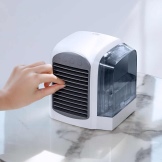



Remember to seek the help of sellers and customer reviews when looking for the perfect air conditioner for you and your family.Such devices have been popular for several days, and therefore today you can find very high-quality reviews and a huge number of reviews on popular models.
How to do it yourself?
Despite the fact that the most primitive models of mini-air conditioners cost a penny, some people express a desire to make such a device on their own. In principle, this is easy to implement - the simplest mini-air conditioner can be made from available tools within 2 hours. Below is a list of the components that will be needed to create the simplest air conditioner.
- 2 conventional plastic coolers. Typically, computer options are used here, designed to cool the processor or video card.
- An ordinary plastic container with a volume of no more than 8 liters.
- Plastic bent pipes (always without cracks) for air and condensate drainage. You need 2 of them to work properly. They can be bought at any hardware store in the plumbing department.
- A conventional 12 W power supply.
- Several half-liter plastic containers or containers.
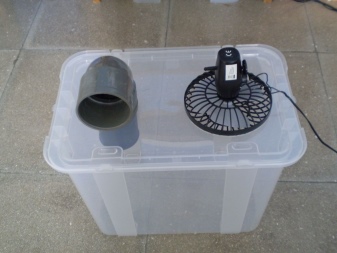

A list of tools that will come in handy when creating a homemade mini air conditioner.
- superglue or silicone glue;
- stationery knife;
- marker;
- insulating tape for insulating and fixing pipes.
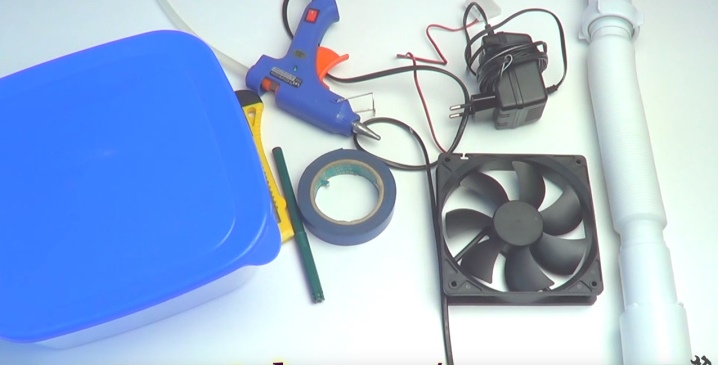
Assembly instructions for a mini home air conditioner.
- Connect both coolers to the power supply unit and check their functionality when plugged into a power outlet.
- Place the fan on the roof of the container in such a way that, when turned on, air flows into the container. Then circle its borders with a marker and cut out a hole for the fan with a clerical knife.
- Place the fan in the prepared hole, secure it with a few screws and seal the holes with silicone glue or electrical tape. When using two coolers, place one directly on top of the other and secure with screws as well. Experts advise installing one, but powerful cooler.
- On the side of the container, make a hole for the air exhaust pipe. Position the tubing so that one end is in the container and the other is pointing up when exiting.
- Connect the fixed pipe to the second pipe without the help of fixing elements and glue. With it, you can change the direction of the air supply.
- Plug the coolers into a power outlet and check if air is coming out of the pipes and if there are leaks. If there is, just fill them with glue or silicone.
- The next step is to prepare the cooling element - pre-frozen ice cubes in half-liter containers are best suited here. Place ice containers in a large container and turn on the fans.
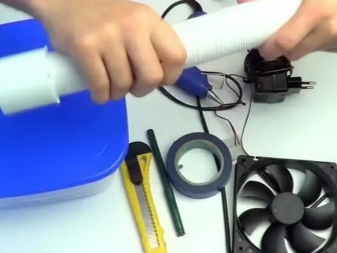
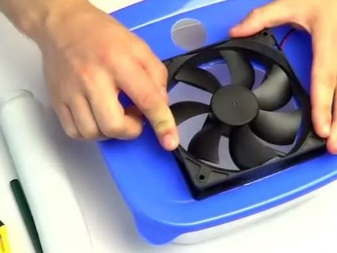

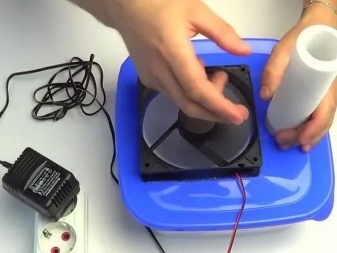
Such a primitive mini air conditioner will work for about 2 hours. During this time, the ice in the blanks will gradually melt, and therefore it will have to be periodically changed to obtain cool air streams.
User manual
Unfortunately, there is no single instruction manual for all known types of mini-air conditioners. Each model has its own requirements for installation, use and care, which must be comprehensively stated in the user manual. You can only highlight the general rules for the use of mini-air conditioners.
- Keep all components of your machine clean. If it is a mobile device with filters, remember to constantly clean or replace these filters. In addition, the fan blades of each air conditioner eventually become covered with a layer of dust and dirt, which can create an unpleasant odor or dry out the air.
- Try to constantly monitor the condition of the fasteners and the integrity of the elements of your air conditioner. If you encounter some kind of internal breakdown or observe a gradual deterioration in the operation of the device (while you are not able to identify the cause on your own), contact a specialist or use warranty repair.It is worthwhile to self-repair complex ventilation devices only as a last resort.
- If you have chosen a split system as a mini air conditioner, be careful about finding a suitable place for it. The device should not interfere with movement around the room or be within the reach of children and animals.
- Carefully study the user manual and instructions for use of your particular air conditioner model. There should be indicated the recommended timing for replacing the refrigerant or some of the constituent elements.

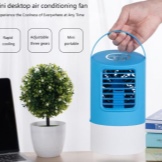


For information on how to use the mini-air conditioner correctly, see the next video.













The comment was sent successfully.